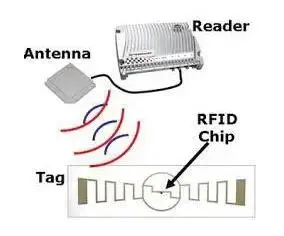The Internet of Things consists of three key technologies: connectivity, identification, and data manipulation.
Previously, we have talked a lot about the technology of how objects in the Internet of Things connect to the network, and in fact, the identification of objects is the first step in the implementation of the Internet of Things, that is, we must uniquely identify and distinguish each object.
The object identification technology represented by RFID was once almost synonymous with the Internet of Things, and now the evolution of RFID technology NFC plays an important role in various fields. Through this article, let’s talk about the identification technology of Internet of Things devices, what is the relationship between RFID and NFC?
RFID
Contactless radio frequency identification (RFID) is essentially a wireless communication technology that transmits data through wireless electromagnetic waves. However, unlike the general communication technology, its purpose is not to make phone calls or send text messages, RFID is mainly used to identify and track the tag bound on the object, so as to achieve the management of the object.
FID technology is widely used in warehousing and logistics for tracking goods
RFID systems use tags (tags) to identify objects. In addition to the tag, the RFID system has a two-way wireless transceiver, called a Interrogator/Reader, that sends a signal to the tag and reads the tag’s feedback.
RFID system consists of reader and tag

RFID is divided into passive RFID and active RFID. Passive RFID generally refers to passive RFID without batteries, which completely relies on receiving electromagnetic waves to drive the circuit to work, and the identifiable distance of the tag does not change. Active RFID systems generally refer to active RFID tags, whose identification distance decreases with the reduction of power.
The ETC system using RFID technology makes access more convenient
Active RFID generally has a long identification distance, such as the ETC system of automatic toll stations on highways and automatic parking lots, which generally uses active RFID working at 2.4GHz. However, there is a battery in the ETC label, and if the battery is dead, it needs to be replaced before it can work.
RFID tag
RFID tags are composed of two parts: Integrated Circuit (IC) and antenna:
IC is used to store and process data, modulate and demodulate RF signals, and collect energy from the signal sent by the reader to drive itself.
The purpose of an antenna is to transmit and receive wireless signals.

EPC code format, EPC code may gradually replace the traditional UPC code, that is, the commodity bar code
What is stored in RFID tags?
The data format stored in RFID tags is generally EPC(Electronic Product Code) code. EPC codes can identify all objects in the world. The structure of the EPC code is defined by the EPCglobal Tag Data Standard, a public standard that can be downloaded free of charge from the EPCglobal Inc website.
NFC technology
After talking about RFID, let’s talk about Near Field Communication (NFC). NFC is a very common communication interface for mobile phones. It allows smart devices to exchange data by getting close to each other. NFC devices can also communicate with a passive NFC tag in the same way that RFID does.

NFC technology is evolved from RFID technology, in addition to the communication protocol, the NFC standard also specifies the data exchange format. The combination of inductive card reader, inductive card and point-to-point functions on a single NFC chip enables identification and data exchange with compatible devices at short distances. NFC can be understood as a subset of RFID technology, using the 13.56MHz band, while RFID also includes other bands. RFID has a lot of working frequency bands, the low frequency band has 125KHz, the high frequency band has 13.56MHz, the ultra-high frequency band has 433.92MHz, 915MHz, and the microwave band of 2.45GHz. (2) Communication distance NFC is called near field communication, and the communication distance is indeed very close, not more than 0.1m. There are many kinds of RFID, and the identification distance is not the same. Like RFID access cards, the identification distance is similar to NFC. However, for such application scenarios as ETC, the identification distance is relatively long. The identification distance of long-distance RFID can reach tens of meters or even hundreds of meters. (3) Application scenarios RFID whether active or passive, the main work is still used for the identification of objects, logistics, transportation, warehousing are widely used RFID technology to track goods. NFC chips are more integrated, including card readers and labels in one. In addition, the two-way communication capability of NFC has been enhanced. In other words, NFC can not only be used as a label for identification, but also as a two-way communication method for data exchange. Currently, NFC is most commonly used in the field of payments.

NFC technology is widely used in payment scenarios
In general, although NFC is developed on the basis of RFID technology, it is not a substitute for different application scenarios.
